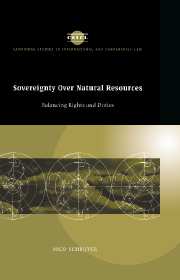Book contents
- Frontmatter
- Contents
- List of boxes, figures and tables
- Preface
- Acknowledgments
- List of abbreviations
- List of main symbols used in UN documents
- Glossary
- Table of cases
- 1 Introduction
- PART I The birth and development of the principle: the UN General Assembly as midwife
- Introductory remarks to Part I
- 2 The formative years (1945–1962)
- 3 Promoting economic development by the exercise of permanent sovereignty: the period after 1962
- 4 Permanent sovereignty, environmental protection and sustainable development
- 5 Permanent sovereignty over natural resources in territories under occupation or foreign administration
- PART II Natural-resource law in practice: from creeping national jurisdiction towards international co-operation
- PART III Balancing rights and duties in an increasingly interdependent world
- Appendices
- Bibliography
- Index
- Books in the series
2 - The formative years (1945–1962)
Published online by Cambridge University Press: 23 October 2009
- Frontmatter
- Contents
- List of boxes, figures and tables
- Preface
- Acknowledgments
- List of abbreviations
- List of main symbols used in UN documents
- Glossary
- Table of cases
- 1 Introduction
- PART I The birth and development of the principle: the UN General Assembly as midwife
- Introductory remarks to Part I
- 2 The formative years (1945–1962)
- 3 Promoting economic development by the exercise of permanent sovereignty: the period after 1962
- 4 Permanent sovereignty, environmental protection and sustainable development
- 5 Permanent sovereignty over natural resources in territories under occupation or foreign administration
- PART II Natural-resource law in practice: from creeping national jurisdiction towards international co-operation
- PART III Balancing rights and duties in an increasingly interdependent world
- Appendices
- Bibliography
- Index
- Books in the series
Summary
This chapter analyzes the development of the principle of permanent sovereignty over natural resources through the political organs of the United Nations in the period up to 1963. The chapter first discusses the concerns during the immediate post-war years regarding the scarcity, optimum utilization and conservation of natural resources, which led to a number of initiatives in the UN. Part of the discussion relates to the question whether a State has the right to dispose freely of its own natural resources or that, in the management of its natural resources, it should take into account the overall needs of the world economy as well.
Latin American countries, especially Chile, took the initiative of introducing the principle of permanent sovereignty in the UN. They used the United Nations as the main forum to express their uneasiness about their relationship with the United States, which they perceived as very unequal. Consequently, they consistently emphasized principles such as national sovereignty, sovereign equality and non-intervention as well as the primacy of national law and domestic courts. Their initiatives resulted, first, in General Assembly Resolution 626 (VII), often perceived as the genesis of the principle of permanent sovereignty but which became branded as ‘the nationalization resolution of the Seventh General Assembly session’.
- Type
- Chapter
- Information
- Sovereignty over Natural ResourcesBalancing Rights and Duties, pp. 36 - 81Publisher: Cambridge University PressPrint publication year: 1997



